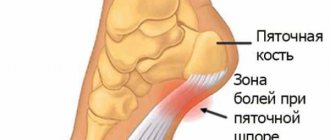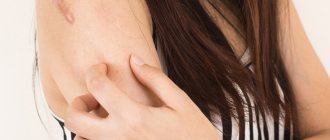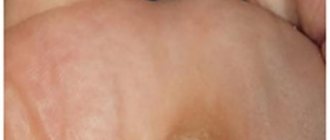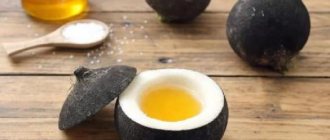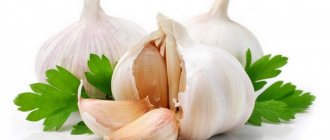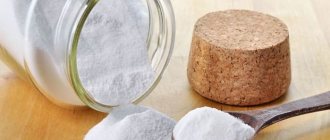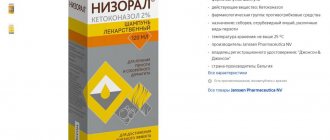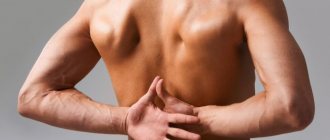general information
The spur develops against the background of chronic inflammation of the plantar (plantar) fascia. This is a thin but very strong piece of connective tissue that connects the toes and heel bone. It is responsible for the formation of the arch of the foot and experiences significant stress during walking.
These loads often cause microdamage to the tissue, which heals on its own during the night's rest. If this process does not happen quickly enough, the trauma is repeated in the morning. When a person gets out of bed, he feels pain of varying intensity. Regular damage to the fascia inevitably leads to the development of an inflammatory process, which gradually increases.
Inflammation begins to involve nearby tissues, in particular bone and tendons. On the surface of the bone tissue, the deposition of calcium salts and the growth of a process (osteophyte), which is called a heel spur, begins. It further damages the fascia, and the pathological circle closes. Without the help of a doctor, walking becomes unbearably painful.
A spur can form on only one heel, or it can affect both feet. It all depends on the individual predisposition of the person.
Make an appointment
Additional research methods
The diagnosis of plantar fasciitis is usually made based on patient complaints and clinical examination. X-rays of the feet are not necessary to make a diagnosis. However, if an x-ray is nevertheless prescribed, a heel spur is visualized on the lateral projections.
It is important to understand that overload of the plantar fascia can cause excessive bone formation, in the form of heel spurs. However, the presence of a heel spur does not directly correlate with symptoms.
In many patients, a spur is visible on radiographs of the foot, but there are no symptoms, and vice versa - in patients suffering from plantar fasciitis, a heel spur is absent on radiographs.
Initially, patients are not prescribed MRI of the foot. However, if symptoms do not improve after treatment, an MRI may be ordered to rule out other causes of heel pain, such as a stress fracture of the calcaneus.
Causes
A heel spur, as well as the plantar fasciitis that causes it, is a multifactorial disease. Its occurrence is due to the complex influence of several reasons:
- old age (the risk of the disease increases after 45-50 years of age due to changes in metabolism and decreased blood supply to the lower extremities);
- obesity (excess body weight causes excessive load on the fascia);
- flat feet, incorrect gait (the load on the foot is distributed unevenly, which leads to increased trauma to its individual areas);
- wearing shoes that are incorrect from an orthopedic point of view (excessively tight, high heels, etc.);
- curvature of the spine (scoliosis) and some other diseases of the musculoskeletal system;
- pregnancy (shift in the center of gravity, changes in hormonal levels and metabolism);
- features of the profession due to which a person is on his feet for a long time (salespeople, waiters, promoters, many blue-collar professions) or is often forced to carry heavy loads;
- professional sports;
- hereditary predisposition;
- metabolic disorders associated with increased deposition of salts in tissues (in particular, gout);
- vascular diseases, in particular, atherosclerosis of the vessels of the lower extremities, obliterating endarteritis (increase the risk of developing spurs due to impaired blood supply to tissues and deterioration of regeneration processes);
- injuries of the spine, lower extremities;
- diabetes;
- diseases of the bones and joints of the legs (arthrosis, rheumatoid and psoriatic arthritis, etc.), as well as the use of hormonal agents for their treatment.
Symptoms
The symptoms of a heel spur depend not on the cause of the disease, but on the location and size of the bone growth, as well as the degree of neglect of the process.
The first sign of trouble is pain. At the initial stage of development of the disease, it is felt at the level of mild discomfort and only in the morning hours. Many people report a feeling of a nail in the heel while walking, which soon disappears.
As the disease progresses, pain begins to appear after prolonged use of the legs and gradually intensifies. The intensity of sensations depends not so much on the size of the process, but on its location. The closer the osteophyte is to the nerve endings, the more painful the leg is. An acute attack can be provoked by sudden support on the heel (when getting up from a chair or bed) or climbing stairs. In rare cases, the disease is practically asymptomatic, but inflammation is still present, and a bone spike is detected during examination.
If acute inflammation of the plantar fascia joins the process, patients note:
- constant tingling and feeling of heat in the heel area;
- redness of the skin in the affected area;
- roughening of the skin of the feet;
- increased pain when walking.
Over time, the pain syndrome becomes habitual, and the person’s gait changes. He begins to place his foot so as not to touch the affected area and rests mainly on the toe and side of the foot. This often causes the development of transverse flatfoot, which further aggravates the course of the disease.
In severe cases, the ability to walk independently is completely lost due to unbearable pain when supporting the leg.
Diagnostics
An orthopedic surgeon diagnoses and treats heel spurs. The main way to identify pathology and assess the degree of its development is radiography. The image clearly shows the bone growth, its shape, location and size.
Additional examination techniques include:
- general and biochemical blood test to identify the inflammatory process, assess the level of uric acid (important for diagnosing gout) and some other indicators;
- Analysis of urine;
- Ultrasound of the foot to assess the condition of soft tissues and identify a possible abscess;
- duplex examination of the vessels of the lower extremities (detects possible circulatory disorders);
- MRI of the foot to determine the condition of all anatomical structures of the foot, including nerve fibers.
If there are concomitant diseases, appropriate laboratory and instrumental studies and consultations with specialists are prescribed.
It is important to remember that heel pain does not necessarily indicate the development of a heel spur. Similar symptoms can be caused by:
- gout;
- rheumatoid arthritis;
- osteomyelitis (inflammation of bone tissue);
- Bekhterev's disease;
- bone tuberculosis;
- injuries, etc.
You should not self-medicate or take painkillers uncontrollably. Only a doctor can choose the appropriate regimen.
Clinical treatments
No matter how effective traditional medicine may seem, limiting yourself to their use is absolutely unreasonable and unacceptable. A full medical examination and the prescription of adequate therapy are absolutely necessary, because plantar fasciitis is a serious disease.
Which doctor should you contact?
If you experience symptoms of a heel spur, you should consult an orthopedic doctor or surgeon. After examination and carrying out the necessary diagnostic tests, the doctor prescribes a treatment regimen, selects suitable orthoses, and, if necessary, gives a referral to see specialists of another profile (physiotherapist, massage therapist, exercise therapy instructor, etc.).
What are the most commonly used clinical treatments for heel spurs?
X-ray therapy
Radiation therapy is used when conservative treatment is ineffective and pain is persistent. Local exposure to x-rays on tissue in the area of bone growth produces a prolonged analgesic effect. Treatment is carried out in several sessions, the duration of one procedure is about 10 minutes. Contraindications to X-ray therapy are pregnancy and breastfeeding.
Blockades
Drug blockades are carried out in cases where conservative therapy for plantar fasciitis does not bring the desired result. Injections of drugs into the area of the pathological focus have an analgesic effect and eliminate inflammation in the tissues.
Injections
For intense pain in the heel area, injections with hormonal drugs of steroid origin (hydrocortisone, diprospan, kenalog) have a good effect. Injections of these drugs into the osteophyte area quickly relieve pain and relieve inflammation.
Medicines
Conservative treatment of heel spurs is carried out in combination with drug therapy. The group of medications used in this case includes:
- analgesic drugs;
- non-steroidal anti-inflammatory drugs (ibuprofen, diclofenac);
- hormonal drugs of steroid origin (hydrocortisone);
- local anti-inflammatory drugs (dimexide, etc.).
Heel spur treatment
Treatment for heel spurs largely depends on its causes and symptoms and is prescribed on an individual basis. Doctors use several techniques:
- drug treatment;
- physiotherapy - shock wave exposure; laser treatment;
- X-ray therapy;
- massage;
- physical therapy and gymnastics;
The patient is required to adjust their lifestyle and diet, as well as wear orthopedic shoes.
Drug treatment
Medicines used in the treatment of heel spurs are aimed at relieving inflammation and pain. Most in demand:
- non-steroidal anti-inflammatory drugs (NSAIDs): products based on indomethacin, diclofenac, ibuprofen in the form of tablets, injections and local products (creams, ointments, pain-relieving patches);
- long-acting corticosteroid drugs (diprospan and its analogues) are injected directly into the fascia to stop the inflammatory process;
- antibiotics in the presence of purulent inflammation or in the infectious nature of the disease.
If there are concomitant diseases, drugs are prescribed to treat them, for example, drugs to normalize blood flow, anti-gout drugs, etc. Only a doctor is responsible for selecting specific medications, their dosage and regimen.
Physiotherapy
Physiotherapy is aimed at improving blood supply and tissue regeneration, as well as enhancing the effect of medications. For this we use:
- electrophoresis: introduction of drugs into tissue using electric current;
- sonophoresis: treatment of tissues with ultrasonic waves that improve the penetration of drugs;
- ultrasound therapy: heating tissues and reducing inflammatory reactions using ultrasonic waves;
- mud and mineral baths.
Shock wave therapy
Shock wave therapy is one of the most effective methods for treating heel spurs in the early stages of development. The technique is based on the influence of ultrasonic waves of a certain frequency, which promotes:
- destruction of calcium deposits;
- reducing inflammation and swelling;
- activation of tissue regeneration.
If the size of the heel spur is small, the technique allows you to get rid of it completely, and in advanced cases it slows down or stops its growth.
Laser exposure
Warming up the deep layers of tissue with a laser helps improve blood flow in them. As a result, the quality of supply of oxygen and nutrients to cells improves, metabolic processes and restoration of affected tissues are activated.
X-ray therapy
This method of treating heel spurs is only suitable for people under 40 years of age and is used extremely rarely if other methods do not work. The affected area is exposed to x-rays in a certain dosage. As a result, persistent pain relief and improvement in condition are achieved.
Surgery
All previous techniques are aimed at relieving pain and inflammation, as well as improving the patient’s condition. A correctly selected set of techniques helps to slow down the process of spur growth or even stop it completely, but it does not allow you to get rid of it completely. The exception is shock wave therapy, but it destroys only very small growths.
The only way to get rid of a large heel spur is through surgery. When choosing the classic version of the operation, the surgeon cuts the fascia completely and immediately removes the bony protrusion. With complete tissue transection, the patient's foot anatomy and gait change significantly, which becomes the reason for assigning a disability group.
A more modern and gentle technique is radiofrequency microtenotomy. The essence of the operation is to eliminate damaged tissue using radio frequency waves.
On the Internet and popular literature you can find a large number of home methods for treating heel spurs using herbs and homemade compresses. Using them without prior approval from a doctor is strictly prohibited. At best, the patient’s condition will remain unchanged, at worst, complications will arise, for example, burns.
Make an appointment
How to choose an ointment for heel spurs at home?
When talking about how to get rid of heel spurs using folk remedies, you need to remember about daily foot care. The presence of a spur requires particularly strict adherence to hygiene and antiseptics.
Daily care for feet with spurs includes:
- examining the spur for inflammation, development and infection;
- washing feet;
- treatment with special creams or ointments for the feet.
For regular use, you can use ointments from the Pyatkashpor series. This series contains three types of ointments designed specifically for people with heel spurs. "Pyatkashpor" contains natural bile, which effectively removes growths, softens rough skin and moisturizes.
For inflamed heel spurs, Pyatkaspor Reinforced is recommended; after eliminating the pain and reducing the spur, Pyatkaspor Regular can be used. After completion of treatment, Pyatkashpor Prophylactic is applied as a prophylactic agent.
Gymnastics for heel spurs
Physical therapy exercises are one of the important factors in the treatment of heel spurs. It helps improve blood circulation in the affected area, which means it stimulates tissue restoration, subject to regular exercise. The minimum complex includes the following exercises:
- squats: the patient bends one leg and puts it forward, takes the other back, feet are on the same line, palms rest on the wall; from this position, squats are performed without lifting the heel off the floor;
- rolling an object: in a sitting position, the patient rolls a small ball or water bottle with his foot for 5 minutes;
- “step”: feet are placed on a threshold, step or stack of books so that the heels hang in the air, bends forward with support on a chair to stretch the muscles of the ankle joint; in the maximum tilt position, you need to freeze for 5-20 seconds, and then return to the starting position;
- collecting objects: using your toes, you need to lift small objects from the floor: peas, beads, beans, etc.; Ideally, the exercise is performed standing, but a sitting position is also allowed;
- stretching: the patient sits on a chair, places the foot of one leg on the knee of the other and with his hands pulls the toes toward himself, while simultaneously turning the foot outward; the exercise stretches the heel fascia well;
- cool-down: the final exercise is performed using a jump rope, a rubber expander, a towel, the patient stretches his legs forward in a sitting position, passes the band under the feet and pulls them towards himself.
The ideal time to practice is in the morning, when the feet are not yet overloaded.
Surgery
Surgical treatment is indicated if conservative therapy is ineffective within 6 months. Also, an indication for surgical intervention is a decrease in performance due to pain. Surgical treatment of heel spurs is resorted to in 5% of cases.
There are several ways to surgically remove a thorn in the area of the heel tubercle:
- Traditional. It is carried out in any hospital setting. It is considered the most common and traumatic surgical technique. The recovery period after open surgery is up to 2 months.
- Endoscopic. The operation is performed using endoscopic instruments that are inserted into the heel area through a minimal incision. Endoscopic surgery is the technique of choice due to its low morbidity and rapid recovery period in the postoperative period.
- Minimally invasive. The newest method for treating heel spurs. The operation is performed under X-ray control. Through an incision, a thin tube is inserted into the heel area, at the end of which a microscalpel is located. With its help the thorn is cut off. Minimally invasive surgery is the least traumatic of all available techniques.
An integrated approach to the treatment of heel spurs is the key to getting rid of the disease as quickly as possible. The choice of therapy method is determined by the attending physician based on preliminary diagnosis of bone formation.
In order to relieve pain when walking, experts recommend wearing orthopedic insoles or heel pads during the treatment of heel spurs. The purposes of their use are:
- Relieves stress on the heel.
- Prevention and treatment of flat feet.
- Improving blood circulation and trophism in the affected area.
- Strengthening the ligamentous apparatus of the foot.
- Fixation of muscles and ligaments of the foot.
The selection of the necessary orthopedic products is carried out by an orthopedic doctor based on individual characteristics. The weight and stage of development of the heel spur are taken into account.
The Yusupov Hospital treats heel spurs and other diseases of the musculoskeletal system in Moscow. In a clinical setting, it is possible to carry out a complete diagnosis and appropriate treatment of heel spurs. The clinic's highly qualified specialists have many years of experience in treating such diseases. Doctors at the Yusupov Hospital provide conservative treatment and surgical excision of the spine in the area of the heel tubercle.
| Drug therapy | Physiotherapy | Surgery | |
| Treatment methods | To treat heel spurs, the following groups of medications are used: 1. Non-steroidal anti-inflammatory drugs. Due to their action, they reduce the permeability of the vascular wall, relieving edema, and also blocking inflammatory mediators. In this way, an analgesic and anti-inflammatory effect is achieved. Drugs of the NSAID group improve blood circulation in the pathological focus and accelerate trophic processes. 2.Chondroprotectors. Medicines in this group restore the tissues that make up the vertebrae. This effect improves blood circulation and nutrition in the affected area. Chondroprotectors help restore the plantar ligament, increasing its elasticity and preventing re-injury | The treatment complex for heel spurs includes the following physiotherapeutic procedures: 1. Phonophoresis. The procedure involves introducing hydrocortisone ointment into the body using ultrasound. Thanks to this, there is an anti-inflammatory effect, microcirculation, trophism and lymph outflow in the affected area improves. 2.Laser therapy. A laser beam is used to target the inflammatory focus. The effect of this method of physiotherapeutic treatment is based on improving blood circulation, reducing edema, relieving pain and reducing the inflammatory process. The effect accelerates the healing and restoration of the injured plantar ligament. Laser therapy is a safe and painless treatment method. Contraindications for the procedure are pregnancy, tuberculosis, hematological diseases, acute liver and kidney failure. 3. Shock wave therapy. The procedure involves applying an ultrasonic wave to the area of bone growths. As a result, pieces of osteophytes break off with their subsequent resorption. Ultrasound treatment improves blood circulation and nutrition in the affected area, relieving pain and inflammation. As a result of therapy, the plantar ligament becomes elastic, which reduces the possibility of re-injury. Shock wave therapy is indicated in the presence of diseases of the musculoskeletal system, flat feet, heel spurs. Contraindications for this method of treatment are pregnancy, cancer, bleeding disorders, acute pathologies accompanied by purulent inflammation. 4. X-ray therapy. To relieve pain, nerve endings are blocked using a low dose of radiation. 5.Magnetic resonance therapy. This method of physiotherapeutic treatment is used to reduce pain, relieve inflammation and improve blood circulation in the heel area. | There are several ways to surgically remove a thorn in the area of the heel tubercle: 1. Traditional. It is carried out in any hospital setting. It is considered the most common and traumatic surgical technique. The recovery period after open surgery is up to 2 months. 2.Endoscopic. The operation is performed using endoscopic instruments that are inserted into the heel area through a minimal incision. Endoscopic surgery is the technique of choice due to its low morbidity and rapid recovery period in the postoperative period. 3. Minimally invasive. The newest method for treating heel spurs. The operation is performed under X-ray control. Through an incision, a thin tube is inserted into the heel area, at the end of which a microscalpel is located. With its help the thorn is cut off. Minimally invasive surgery is the least traumatic of all available techniques. |
| Indications | Drug therapy is part of the complex treatment of diseases of the musculoskeletal system, accompanied by pain and inflammatory syndrome. | Physiotherapy is indicated for diseases of the musculoskeletal system, flat feet, and heel spurs. | Surgical treatment is indicated if conservative therapy is ineffective within 6 months. Also, an indication for surgical intervention is a decrease in performance due to pain. |
| Contraindications | Limitations for drug therapy are acute febrile conditions, gastrointestinal bleeding, and individual intolerance to the components of the drug. | Contraindications for physiotherapeutic procedures are pregnancy, tuberculosis, hematological diseases, acute liver and kidney failure. | Limitations for surgical intervention are: § Acute conditions accompanied by an increase in body temperature. § Purulent inflammation of any localization. § Severe concomitant pathology. |
Massage
Massage is another way to improve blood circulation in the feet with heel spurs. The simplest complex can be done independently. The feet are first warmed up by intense rubbing, after which the active effect begins:
- small pinches with gradual movement from the tips of the fingers to the heel;
- rubbing the heel: performed with the pads of the fingers with force in different directions;
- circular rubbing: first the outer radius of the heel is grabbed, then the circles are concentrated on the spike area;
- kneading: the spur area is intensively kneaded with the thumbs;
- light tapping with the edge of the palm.
The exposure cycle is repeated 2-3 times and ends with rubbing and stroking. At the end, if necessary, an anesthetic ointment is used.
It is important to remember that the massage should not be overly painful, but slight pain is a sign that the exercises are being performed correctly. For additional stimulation of the affected area, you can use a massage mitt.
In addition to classic manual massage, the use of special relief mats and electric massagers is allowed.
Diet
Nutrition for heel spurs has several goals:
- reduce body weight and prevent its increase;
- minimize inflammatory processes;
- remove excess salts from the body.
Doctors recommend adhering to the following rules:
- control the daily caloric intake of food, prevent overeating;
- in the absence of contraindications, drink at least 2-3 liters of clean water daily (tea, coffee, juices and other drinks do not count);
- balance the menu in terms of proteins, fats and carbohydrates, provide a sufficient amount of vitamins;
- do fasting days regularly;
- minimize the consumption of spicy, hot, smoked, salty foods, sauces, canned food, as well as products containing artificial flavors;
- exclude strong broths, mushrooms, offal, coffee, alcohol from the diet;
- reduce the amount of salt;
How to treat heel spurs at home with foot baths?
The best option is a bath after therapeutic exercises for heel spurs, containing special exercises.
Foot baths for feet with heel spurs have a positive effect:
- soothe, relieve pain;
- soften growth and rough skin;
- soften calluses and corns;
- disinfect, eliminate unpleasant odors.
The most popular bath recipes are:
Salt + soda.
To prepare, take the hottest water you can tolerate. Pour 3-4 tbsp. spoons of table salt and soda. Lower your feet and hold them until the water cools. It is better to take such a bath in the evening.
After the procedure, carefully dry your feet with a towel and apply cream. The best option is to use a product made specifically for heel spurs.
For example, Pyatkashpor ointments effectively moisturize the skin and help reduce bone spurs.
Iodine + salt.
How to treat heel spurs with iodine and salt? Dissolve 2-3 liters in water at a temperature of +45-50 C. salt and add one ampoule (approximately 50 drops) of iodine. Steam your feet until the water cools completely. After the bath, it is advisable to wear warm socks.
Iodine has a disinfecting effect, and salt softens the growth, eliminating discomfort. To enhance the positive effect, you can take sea salt rather than table salt.
Clay.
Clay baths are indicated for inflammatory conditions. Clay also removes salt deposits well, which cause inflammation of the heel fascia.
It is better to buy clay at the pharmacy, but you can also take regular clay, for example from the garden. The amount of clay is determined “by eye” - the water should become cloudy after adding it.
Prevention
The development of heel spurs can be prevented and significantly slowed down by lifestyle changes. To avoid problems associated with inflammation of the plantar fascia, you must:
- wear comfortable shoes with small, comfortable heels (recommended height 2-4 cm);
- use orthopedic insoles with arch support;
- maintain body weight at a normal level, prevent obesity;
- provide a complete, balanced diet, drink enough clean water;
- engage in recreational sports that bring pleasure;
- minimize overload of the feet (long walking or standing);
- periodically massage the feet (the exercises are similar to the therapeutic effect);
- promptly and fully treat postural disorders and flat feet.
At the first sign of pain in the heel area, you should consult a doctor for examination. Many physiotherapeutic techniques are effective at an early stage and allow you to completely get rid of the spur before it makes life unbearable.
TOP 10 recipes: how to cure heel spurs at home
We offer 10 best recipes for getting rid of inflamed heel fascia at home:
Recipe 1: Onions and garlic.
Regular fresh garlic against heel spurs is effective due to the presence of powerful immune-stimulating substances in its composition. In combination with onions, which are rich in phagocytes, this gives an excellent anti-inflammatory result.
To prepare the compress, you need 1 medium-sized onion and 3-5 cloves of garlic, which are crushed. The resulting paste must be applied to the spur and kept for at least two hours.
Recipe 2: Rubbing alcohol.
The alcohol must be heated to +40 C and the foot should be lowered until it cools completely. You can use regular vodka. This remedy is especially effective in the evening, when pain from heel spurs prevents you from falling asleep.
Recipe 3: Vinegar and raw chicken egg.
Treatment of heel spurs with vinegar and raw egg is based on the ability of these substances to soften the heel spur. It’s very simple to prepare the ointment: break 1 egg, pour in 1/2 tbsp. 9% vinegar and 100 g butter. Stir and melt the mixture over low heat. When heated, the ointment will thicken. Apply to the affected heel at night.
Note: it is recommended to wear special orthopedic heel pads during the day. They will help relieve pain and discomfort when walking and speed up the treatment process.
Recipe 4: Potatoes.
Raw potatoes, especially young ones with a high starch content, help reduce the thorn. The potatoes are grated and the resulting porridge is applied to the heel. It is recommended to repeat every evening.
Recipe 5: Propolis.
This product is an excellent natural antiseptic and has an analgesic effect. Lotions with propolis help to dissolve the heel spike. Before use, propolis must be softened in a water bath. You need to keep the lotion at night.
Recipe 6: Salt compress.
Regular treatment of heel spurs with salt relieves pain well. To prepare, you need to take sea or table salt, add a spoonful of honey and a couple of drops of iodine. Apply the resulting thick mixture to the sore heel and hold for half an hour.
Another recipe with salt that requires stamina: dissolve 500 g of salt in boiling water and dip your heels in it. This method is not recommended in the presence of acute inflammation and wounds on the feet.
Recipe 7: Pharmacy turpentine.
Used to relieve pain in the absence of inflammation and open injuries of the foot. The sore spot is rubbed with turpentine, and a cotton sock is put on top.
The procedure is best done at night and combined with an orthopedic orthosis or Strasbourg sock.
Recipe 8: Burdock.
Burdock leaves are crushed to a porridge consistency. For severe pain, you can crush and add an aspirin tablet to the mixture. Burdock leaves for heel spurs effectively draw out salts and help get rid of the spur.
Recipe 9: Red pepper.
Take a pinch and put it in your socks. Walk for 6-8 hours. Pepper warms the heel and helps reduce spurs.
Helpful advice: wearing high-quality orthopedic insoles with heel shock absorbers will help to properly unload the feet, eliminate pain and discomfort when walking and speed up the treatment process.
Recipe 10: Aluminum foil.
Quite an extravagant recipe for treating fasciitis. The point of treatment is the effect of metal on the active points of the heel, eliminating pain. To remove a heel spur, you need to take foil, wrap it around your heel and secure it with a bandage.
Consequences and complications
When a heel spur develops, the patient must rest on the toes or side of the foot. This can lead to complications:
- swelling and pain in the ankle joint;
- arthritis and arthrosis of the big toe joint;
- development or worsening of flat feet;
- pronounced violations of posture.
Without treatment, the heel spur grows so large that it completely deprives the patient of the ability to put weight on his foot. The quality of life deteriorates significantly.
Treatment at the Energy of Health clinic
If you are worried about pain or discomfort in your heel, come for an appointment at the Health Energy clinic. An experienced orthopedic doctor will listen and examine you, and also prescribe the necessary examinations. After making a diagnosis, we will offer modern methods of treating pathology:
- blockades for quick pain relief;
- all types of physiotherapy;
- professional therapeutic massage;
- training in physical therapy exercises and exercises under the supervision of a trainer.
Additionally, we will prescribe drug treatment in accordance with modern standards, and also monitor the effect of therapy.
Advantages of the clinic
“Health Energy” is a modern multidisciplinary medical center that offers its patients comprehensive services for the treatment and prevention of diseases. Here are the benefits of contacting us:
- review and expansion of early disease detection programs;
- modern diagnostic equipment;
- qualified medical staff who regularly improve their skills;
- an integrated approach to diagnosis and treatment.
We do everything to provide each patient with maximum comfort from the first minutes of their stay in the clinic. Adequate prices make quality medicine accessible.
A heel spur is just a small bony growth that can, however, completely change a person's life. Don’t delay in seeing a doctor, make an appointment with an Energy of Health orthopedist.
